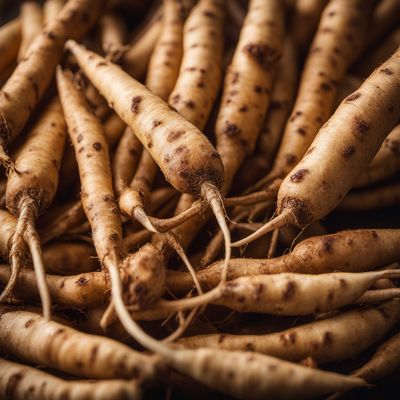
Ingredient
Blue taros
The Vibrant Purple Powerhouse
Blue taros are known for their vibrant purple color, which comes from the presence of anthocyanins, powerful antioxidants. They have a starchy texture and a slightly nutty, earthy flavor. Their appearance is similar to regular taro, but with a beautiful purple skin and flesh.
Origins and history
Blue taros have been cultivated for centuries in Southeast Asia, particularly in countries like Thailand and Vietnam. They have a rich cultural significance and are often used in traditional dishes and celebrations. In addition to their culinary uses, blue taros have also been used for medicinal purposes in traditional medicine.
Nutritional information
Blue taros are a good source of dietary fiber, potassium, and vitamin C. They are also low in calories, making them a healthy addition to any diet.
Allergens
There are no known allergens associated with blue taros.
How to select
When selecting blue taros, look for ones that are firm and free from any soft spots or blemishes. The skin should be smooth and vibrant in color. Avoid taros that have a dull or wrinkled appearance, as this may indicate that they are past their prime.
Storage recommendations
To store blue taros, keep them in a cool, dark place with good ventilation. Avoid storing them in the refrigerator, as the cold temperature can cause them to become mushy. Blue taros can be stored for up to two weeks.
How to produce
Blue taros can be grown in tropical or subtropical regions with well-drained soil. They require a warm climate and plenty of water to thrive. They can be propagated from tubers or by planting the suckers that grow from the main plant.
Preparation tips
Blue taros can be boiled, steamed, roasted, or fried. They can be used in both sweet and savory dishes, such as soups, stews, curries, and desserts. To prepare blue taros, peel the skin and remove any fibrous parts. Cut them into desired shapes and cook them according to the recipe instructions.
Culinary uses
Blue taros are commonly used in Southeast Asian cuisines, particularly in dishes from Thailand and Vietnam. They are often used in curries, stir-fries, and desserts. Blue taro chips and taro bubble tea are also popular.
Availability
Blue taros are commonly available in Southeast Asian countries, such as Thailand and Vietnam. They can also be found in specialty grocery stores or Asian markets in other parts of the world.
More ingredients from this category

Konjac roots
The Versatile Wonder: Unveiling the Potential of Konjac Roots

Canna
"The Versatile Wonder: Unveiling the Culinary Potential of Canna"

Taros
The Versatile Taro Root

Tannias
Versatile Tropical Tubers

Cassava roots
The Versatile Tuber: Cassava Roots

Chayote roots
The Versatile Vegetable: Chayote Roots